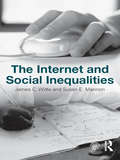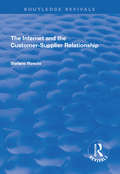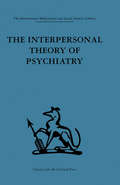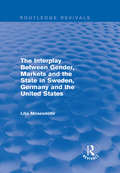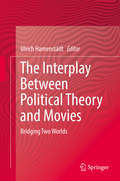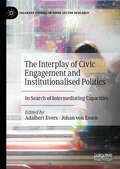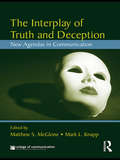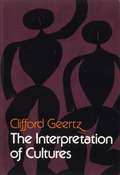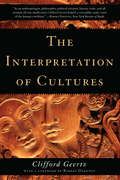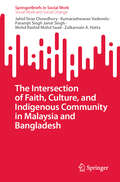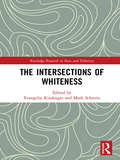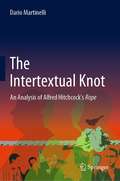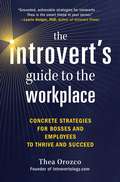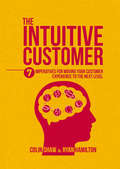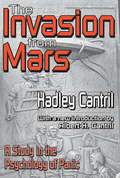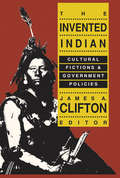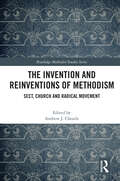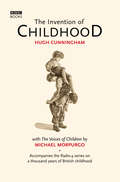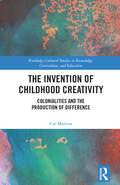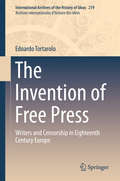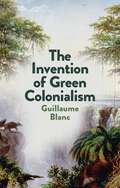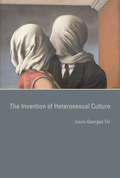- Table View
- List View
The Internet and Social Inequalities
by James C. Witte Susan E. MannonIdeal for use as a core or secondary text in lower division social inequalities or social problems courses, this book explains how the changing nature and uses of the Internet not only mirror today’s social inequalities, but also are at the heart of how stratification is now taking place.? A pioneering work, both intellectually, and pedagogically.
The Internet and the Customer-Supplier Relationship
by Stefano RonchiThis title was first published in 2003. An exhaustive and synthetic framework for the use of Internet tools in customer-supplier relationships is one aspect of e-business that is still missing from existing literature. This book analyses the main management implications related to the adoption of the Internet in the supply chain and unifies different research studies and contributions in order to build such a framework. It is based on wide empirical evidence including four in-depth case studies in both Europe and the US, a cross-industry survey of more than 160 US companies and website research describing emerging Internet initiatives in B2B relationships. By creating a concrete link between theory and practice it should appeal to academics and practitioners alike.
The Interpersonal Theory of Psychiatry
by Harry Stack SullivanTavistock Press was established as a co-operative venture between the Tavistock Institute and Routledge & Kegan Paul (RKP) in the 1950s to produce a series of major contributions across the social sciences. This volume is part of a 2001 reissue of a selection of those important works which have since gone out of print, or are difficult to locate. Published by Routledge, 112 volumes in total are being brought together under the name The International Behavioural and Social Sciences Library: Classics from the Tavistock Press. Reproduced here in facsimile, this volume was originally published in 1955 and is available individually. The collection is also available in a number of themed mini-sets of between 5 and 13 volumes, or as a complete collection.
The Interplay Between Gender, Markets and the State in Sweden, Germany and the United States
by Lilja MosesdottirThis title was first published in 2001. The development of gender relations during the post-war period in Sweden, Germany and the US forms the core of this work. It looks at the hierarchical relations between men and women based on economic, political, social and biological differentiations. The analytical focus is primarily on how actors, cultural norms and institutional arrangements interrelate and affect the relative position of men and women to create patterns/forms of gender relations that vary across countries and change through time. The main advantages of a comparative study is that it highlights the differences and similarities of the countries being compared. This book argues that social blocks involving a stable system of relations that have challenged and become embedded into institutional arrangements are the main force creating differences in the patterns of gender relations across the countries.
The Interplay Between Political Theory and Movies: Bridging Two Worlds
by Ulrich HamenstädtThis book presents essays and scientific contributions examining the link between popular media and politics. The essays focus on the question of how political and social change, concepts of power, and utopian elements are reflected in selected films and television series. The book applies a political science perspective, covering theories from political philosophy, political sociology and international relations, and examines a wide range of movies and TV series, such as The Godfather, Fight Club, The Walking Dead and Game of Thrones. It will appeal to anyone interested in studying how political ideas, concepts and messages can be illustrated and visualized using the complex media of movies and TV series.
The Interplay of Civic Engagement and Institutionalised Politics: In Search of Intermediating Capacities (Palgrave Studies in Third Sector Research)
by Adalbert Evers Johan Von EssenThis volume focusses on the interplay of civic engagement and institutionalised politics and its role in both the erosion and retrieval of intermediate capabilities and procedures. Rather than discussing democracy as a relationship between citizens as individual voters and state power, the book studies the relationship between citizens engaged in or through organisations, movements and networks in civil society, and their impact in the context of institutionalised politics, be that through representative institutions and political parties or participation in administrative governance. The aim of this volume is to renew the scholarly discussion on the prospects of liberal democracy by looking for opportunities to curb antagonisms and instead strengthen intermediary capabilities. The book will therefore be of interest to students in relevant disciplines as political science, civil society research, sociology, and research on social movements. Chapter 1 and Chapter 10 are available open access under a Creative Commons Attribution 4.0 International License via link.springer.com.
The Interplay of Truth and Deception: New Agendas in Theory and Research (New Agendas in Communication Series)
by Mark L. Knapp Matthew S. McGloneDuring the past 30 years, there have been a steadily increasing number of scientific and popular publications dealing with lying and deception. Questions about the extent to which public officials are deceptive are standard fare in current magazines and newspapers. This volume aims to present on a more precise conceptualization of this phenomenon, manifested in some well-known constructions like spin, hype, doublespeak, equivocation, and contextomy (quoting out of context). The contents of the volume have been generated for the New Agendas symposium at the University of Texas College of Communication, and all the authors are young, leading-edge researchers offering innovative perspectives and explorations of lying and deception in various contexts. This volume will appeal to scholars, researchers, and advanced/graduate students in communication, media, and psychology. It is written to the level of advanced undergraduates, and it is appropriate for use in courses covering lying and deception.
The Interpretation Of Cultures
by Clifford GeertzIn The Interpretation of Cultures, the most original anthropologist of his generation moved far beyond the traditional confines of his discipline to develop an important new concept of culture. This groundbreaking book, winner of the 1974 Sorokin Award of the American Sociological Association, helped define for an entire generation of anthropologists what their field is ultimately about.
The Interpretation of Cultures
by Clifford Geertz Robert DarntonIn The Interpretation of Cultures, the most original anthropologist of his generation moved far beyond the traditional confines of his discipline to develop an important new concept of culture. This groundbreaking book, winner of the 1974 Sorokin Award of the American Sociological Association, helped define for an entire generation of anthropologists what their field is ultimately about.
The Intersection of Faith, Culture, and Indigenous Community in Malaysia and Bangladesh (SpringerBriefs in Social Work)
by Jahid Siraz Chowdhury Mohd Rashid Mohd Saad Kumarashwaran Vadevelu Paramjit Singh Jamir Singh Zulkarnain A. HattaThis book is a comprehensive study of the intersection of religion, Indigenous culture, and community life, featuring an in-depth examination of the Orang Asli in Malaysia and the Santals in Bangladesh that aims for a socially inclusive, harmonious, and peaceful society. It dives into the impact of conversion on Indigenous identities, employing extensive ethnographic and phenomenological methodologies. The authors explore the conversion process attentively, revealing hidden isolation. This compact volume offers intriguing insights into Southeast and South Asia's rich tapestry, including nuance to discussions concerning religious pluralism, human rights, and the pursuit of social justice. Readers gain a better understanding of varied religious communities and Indigenous perspectives in order to promote a more inclusive and fair society. In the book, the authors provide real-life experiences, extensive analysis, and practical solutions for Indigenous populations in Malaysia and Bangladesh. They blend together thoughts and narratives, encompassing sociopolitical and historical themes. With visuals, case studies, and varied views, the volume builds respect for global variety while driving societal inclusion with the spirit of the sustainable development goals (SDGs). The Intersection of Faith, Culture, and Indigenous Community in Malaysia and Bangladesh addresses pressing social justice and human rights issues, pushing for rights-based society and diversity, while balancing academic rigor and accessibility. The book is intended for scholars and researchers interested in Indigenous peoples, religious conversion, social justice, and human rights. It offers detailed insights into the conversion experiences of Malaysian Orang Asli and Bangladeshi Santal groups, and provides commentary on civil freedoms following conversion and reveals complex views of these communities, making the volume useful for scholars researching intersectionality in religious conversions and the dynamics surrounding Indigenous populations. Policymakers in Malaysia, Bangladesh, and other Asian countries dealing with comparable concerns with converted Indigenous people might benefit from the book's evidence-based insights and challenges, promoting more inclusive and culturally sensitive policies and urging Malaysian and Bangladeshi governments to recognize conversion-related issues.
The Intersections of Whiteness (Routledge Research in Race and Ethnicity)
by Mark Schmitt Evangelia KindingerTrumpism and the racially implied Islamophobia of the "travel ban"; Brexit and the yearning for Britain’s past imperial grandeur; Black Lives Matter; the public backlash against Merkel’s refugee policies in Germany. These seemingly national responses to the changing demographics in a multitude of Western nations need to be understood as effects of a global/transnational crisis of whiteness. The Intersections of Whiteness brings together scholars from different disciplines to shed light on these manifestations in the United States, the United Kingdom, South Africa and Germany. Applying methodology stemming from critical race theory’s investment in intersectionality, the contributions of this edited collection focus on specific intersections of whiteness with gender, class, space, affect and nationality. Offering valuable insights into the contours of whiteness and its instrumentalisation across different nations, societies and cultures, this incisive volume creates transnational dialogue and will appeal to students and researchers interested in fields such as critical whiteness and race studies, gender studies, cultural studies and social policy.
The Intertextual Knot: An Analysis of Alfred Hitchcock’s Rope
by Dario MartinelliThis book is a thorough analysis of Alfred Hitchcock's Rope (1948) and of its multiple connections with the Leopold and Loeb murder case and the adaptation of Patrick Hamilton’s eponymous play. As an all-encompassing portrait of the movie, the book discusses its aesthetics, style, role within cinema history, challenges in production, innovations introduced and of course Hitchcock’s signature features. However, as the analysis unfolds, the film reveals itself as an actual journey through the nightmares and the hopes that characterized the 20th century. Nazism and anti-Nazism, antisemitism, homophobia, democracy and totalitarianism, capital punishment and second chances, human rights, World War II, misogyny, tolerance and discrimination, Supermanism and humanism, artistic freedom and censorship. Subtly, often between the lines, and with Hitchcock's usual dark humor, Rope is nevertheless a much stronger social and political statement than it was ever given credit for. The Intertextual Knot is aimed at a varied readership, including film scholars, historians, philosophers and film enthusiasts.
The Interview: Research on Its Anatomy and Structure
by Arthur N. WiensNearly two decades of research in clinic, industry, and educational settings have enabled the authors to present this compact but comprehensive report on the structure of the interview process. Joseph D. Matarazzo and Arthur N. Wiens have put together a concise presentation of research evidence; free from the dogged adherence to personal opinion that plagues most literature on the subject. The authors present and discuss basic interview concepts: interviewer and interviewee difference in interview behavior, the stability of such behavior, and conditions, which may modify it (including the first solid evidence, independently cross validated by others, for the effect on the interviewee of specific and common interviewer tactics).The book contains a wealth of data on differences in the interview speech behavior of different types of patients, and between persons in different occupations, different administrative hierarchies, and different professional specialties (for example surgical versus psychiatric nurses). Data from the clinical setting also includes evidence for a new and heretofore unsuspected process variable; i.e., a synchrony in the interruption behavior of the therapist and his patient over many psychotherapy sessions.The undergraduate in the communications fields will find this book an excellent adjunct to any of a number of courses in his special curriculum. Graduate students will find a storehouse of leads for theses and dissertations; while the practitioner and teacher in these fields will find much that is new and important to him in each chapter.
The Intimate Life of Computers: Digitizing Domesticity in the 1980s
by Reem HiluA feminist perspective on the early history of personal computing, revealing how computers were integrated into the most intimate aspects of family life The Intimate Life of Computers shows how the widespread introduction of home computers in the 1980s was purposefully geared toward helping sustain heteronormative middle-class families by shaping relationships between users. Moving beyond the story of male-dominated computer culture, this book emphasizes the neglected history of the influence of women&’s culture and feminist critique on the development of personal computing despite women&’s underrepresentation in the industry. Proposing the notion of &“companionate computing,&” Reem Hilu reimagines the spread of computers into American homes as the history of an interpersonal, romantic, and familial medium. She details the integration of computing into family relationships—from helping couples have better sex and offering thoughtful simulations of masculine seduction to animating cute robot companions and giving voice to dolls that could talk to lonely children—underscoring how these computer applications directly responded to the companionate needs of their users as a way to ease growing pressures on home life. The Intimate Life of Computers is a vital contribution to feminist media history, highlighting how the emergence of personal computing dovetailed with changing gender roles and other social and cultural shifts. Eschewing the emphasis on technologies and institutions typically foregrounded in personal-computer histories, Hilu uncovers the surprising ways that domesticity and family life guided the earlier stages of our all-pervasive digital culture.
The Introvert's Guide to the Workplace: Concrete Strategies for Bosses and Employees to Thrive and Succeed
by Thea OrozcoTap Into Your Natural Introvert Strengths in the Office with Actionable Tips and Advice Introverts make up one half of the population, and we&’re hardwired to thrive—especially in the workplace! However, it&’s not uncommon for introverts to feel out of place in the office, where it seems the only ones succeeding are outgoing personalities ready to toot their own horn. Thea Orozco busts that myth, showing how the workplace is truly a setting for introverts to succeed based on their innate skillset and natural introvert strengths. With topics ranging from overcoming phone phobia to developing an authentic leadership style, The Introvert's Guide to the Workplace guides introverts through thriving at work without having to shout—whether you are a boss, an employee, or a career person. Learn from actionable tips and practical advice, and surmount office challenges and let your introversion take the lead: Combat interview anxietyMake meaningful connections at networking eventsBe heard and noticed at meetings or on the stageOvercome imposter syndromeBecome an effective leader with your introvert strengthsAnd more! Including diverse expert interviews, The Introvert's Guide to the Workplace is every working introvert&’s handbook and guide that they can refer to throughout their career for guidance on tricky or draining situations and motivation to enlist the power of their inner introvert to succeed.
The Intuitive Customer
by Colin Shaw Ryan HamiltonYou can't solve today's problems with yesterday's thinking. In The Intuitive Customer: 7 Imperatives For Moving Your Customer Experience to the Next Level, authors Shaw and Hamilton explore the reasons organizations are struggling to improve their customer measures and are witnessing the plateauing of loyalty scores like Net Promoter. For Shaw and Hamilton, the answer is simple: you need to understand the intuitions that drive your customers' behavior at an emotional, subconscious and psychological level. This book describes where behavioral economics meets customer experience in a very easy to understand and practical way. By taking academic and scientific studies of behavioral economics and consumer psychology and applying them to real-world situations, Shaw and Hamilton present accessible concepts that innovative organization are using today to propel their customer experience strategies to the next level. They also share their proven methodologies and discuss how leading organizations have deployed these tools to great effect--and seen dramatic increases in loyalty scores and ROI as a result. Some of the critical concepts Shaw and Hamilton cover include: · Customers make decisions emotionally. · Customers don't always know why they do what they do. · Every customer has two ways of thinking. · Habits drive many of your customers' decisions. · People use mental shortcuts for decision-making. · Managing your reputation is an important part of the experience. · Customer loyalty is a function of memory. . . . and many more. Shaw and Hamilton have distilled this wisdom down to Seven Imperatives that an organization must embrace to move their customer experience to the next level. With this easy and entertaining read, yours could be next organization to take a massive leap forward.
The Invaders: How Humans and Their Dogs Drove Neanderthals to Extinction
by Pat ShipmanWith their large brains, sturdy physique, sophisticated tools, and hunting skills, Neanderthals are the closest known relatives to humans. Approximately 200,000 years ago, as modern humans began to radiate out from their evolutionary birthplace in Africa, Neanderthals were already thriving in Europe―descendants of a much earlier migration of the African genus Homo. But when modern humans eventually made their way to Europe 45,000 years ago, Neanderthals suddenly vanished. Ever since the first Neanderthal bones were identified in 1856, scientists have been vexed by the question, why did modern humans survive while their evolutionary cousins went extinct?
The Invasion from Mars: A Study in the Psychology of Panic (Princeton Legacy Library #454)
by Hadley CantrilOn Halloween night 1938, Orson Welles broadcast a radio adaptation of the H. G. Wells fantasy, The War of the Worlds. What listeners heard sounded so realistic that at least a million were frightened by word that "strange creatures" from Mars had landed in central New Jersey and were "unleashing a deadly assault." Several thousand were so terrified they ran into the streets, drove away in their cars, or called the police for information about how to escape. Why did so many panic when the circumstances reported were so improbable? That is just the question Hadley Cantril, then a young social psychologist, set out to answer.Originally published in 1940, The Invasion from Mars remains a classic. The broadcast provided a unique real-life opportunity to explore why the relatively new medium of radio could have such an effect. Using a mix of research methods, Cantril shows that the impact of the broadcast had less to do with what went out over the air than with the "standards of judgment" people did or did not use in evaluating what they were hearing. This book is of continuing value to those interested in communications and mass behavior.
The Invented Indian: Cultural Fictions and Government Policies
by James A. CliftonThis is an explosive collection of essays, written by leading scholars of North American Indians, most of them heavily involved in service and applied work, often on behalf of Indian clients, communities, and organizations. In an area saturated with deadening, consciously politicized orthodoxy, these seventeen essays aim at nothing less than the reconstruction of our understanding of the American Indian-past and presentThe volume examines in careful, accurate but uncompromising ways the recent construction of the prevailing conventional story-line about ""America's most favored underclass."" The first eight essays introduce the volume and treat a variety of specific invented traditions concerning Indians. These are followed by four essays on broader, thematic issues related to the demographic, religious, cultural, and kinship elements in Indian studies. The final five chapters express a comparative perspective: from Anglo and French Canada, Europe, from inside the Bureau of Indian Affairs, and from a legal position.The Invented Indian explores how cultural fictions promote divisiveness and translate into policy. Throughout, the volume reveals a deep and abiding respect for Indians, their histories, and their cultures, saving its critiques for jaundiced academics and callow politicians. Representing years of cooperative effort, this work brings together a group providing breadth and balance. Far more than a critical collection, it is a constructive effort to make sense of a field displaying empirical confusions and moral muddles. The volume will be of interest to anthropologists, professionals in Indian studies, and policymakers.
The Invention and Reinventions of Methodism: Sect, Church and Radical Movement (Routledge Methodist Studies Series)
by Andrew J. CheatleThis book focuses on the transformative journey of Methodism and tackles a profound question: How did a radical revival movement evolve into an established mainstream Church? With a global family of around eighty million, Methodism and its Holiness offshoots have come a long way since their origins as a fervent revival within the Church of England in the late 1730s. Once perceived as controversial and charismatic, early Methodists, led by John and Charles Wesley, preached salvation to unruly crowds, often facing fierce opposition. Despite its turbulent beginnings, the Wesleys skilfully kept the movement anchored to its Anglican roots, preventing it from fracturing entirely. This allowed Methodism to evolve into an established church while maintaining its distinct identity. The volume delves into the enduring legacy of early Methodism, exploring its theological influences and developments over time. With its identity wrapped up in dual focus on mission and holiness, Methodism’s impact on global Christianity is profound. From the Holiness movement to the rise of Pentecostalism, its early radical and charismatic practices still resonate in the Church today. Featuring essays from leading Wesleyan scholars, this book is valuable for anyone interested in the dynamic history and lasting influence of the Methodist tradition.
The Invention of Childhood
by Hugh CunninghamThe Invention of Childhood will paint a vivid picture of the lives of children in Britain from pagan Anglo-Saxon times to the present day. Drawing heavily on primary sources, such as diaries, autobiographies, paintings, photographs and letters, the book will present a complete chronological history of the experience of children in Britain during the past 1500 years. We will learn the key elements that have shaped their lives down the ages and how this has differed as a result of gender, geography and ethnicity. The book will also relate children's lives to larger events in national and international history. Written by Hugh Cunningham the Professor of History at the Universtity of Kent at Canterbury, and an expert on childhood history - the book will accompany the Radio 4 series presented by the highly respected children's author Michael Morpurgo. Michael is contributing a lengthy foreword to the book. 'The Invention of Childhood' will expand on a number of key themes from the radio series, including the idea of childhood as a distinct stage of life. Opinions on when childhood should start and end, and how it differs from adulthood have changed considerably down the centuries. And these inventions and reinventions of childhood (hence the title) have had a profound effect on children's lives. The prolonged childhood we enjoy in Britain today was a luxury few could afford in the past. This fascinating study will draw attention to the ways in which we may find childhood and children in the past quite similar to the present and to ways in which childrens lives from the past seem to differ sharply from the lives children lead today.
The Invention of Childhood Creativity: Colonialities and the Production of Difference (Routledge Cultural Studies in Knowledge, Curriculum, and Education)
by Cat MartinsThis text offers a comprehensive analysis of the concept of the modern creative and imaginative child in Western education. Drawing on archived sources and historical works, it reframes childhood creativity as a social, cultural, and scientific construction, asking how our thinking and acting toward the creative child have been produced historically. The text dissects the discursive construction of creativity as a natural and developmental attribute of the child. It argues that the idea of the White creative child, constructed through comparative reasoning, shaped by primitivism, and illustrated through botanical metaphors as close to nature and the senses, is a notion embedded with colonialities, forming part of a Western civilizing project and entrenched power-knowledge relations. A compelling and original account of childhood creativity, this text will appeal to researchers in arts education, early childhood education, curriculum studies, and the history of education.
The Invention of Free Press
by Edoardo TortaroloTracking the relationship between the theory of press control and the realities of practicing daily press censorship prior to publication, this volume on the suppression of dissent in early modern Europe tackles a topic with many elusive and under-researched characteristics. Pre-publication censorship was common in absolutist regimes in Catholic and Protestant countries alike, but how effective it was in practice remains open to debate. The Netherlands and England, where critical content segued into outright lampoonery, were unusual for hard-wired press freedoms that arose, respectively, from a highly competitive publishing industry and highly decentralized political institutions. These nations remained extraordinary exceptions to a rule that, for example in France, did not end until the revolution of 1789. Here, the author's European perspective provides a survey of the varying censorship regulations in European nations, as well as the shifting meanings of 'freedom of the press'. The analysis opens up fascinating insights, afforded by careful reading of primary archival sources, into the reactions of censors confronted with manuscripts by authors seeking permission to publish. Tortarolo sets the opinions on censorship of well-known writers, including Voltaire and Montesquieu, alongside the commentary of anonymous censors, allowing us to revisit some common views of eighteenth-century history. How far did these writers, their reasoning stiffened by Enlightenment values, promote dissident views of absolutist monarchies in Europe, and what insights did governments gain from censors' reports into the social tensions brewing under their rule? These questions will excite dedicated researchers, graduate students, and discerning lay readers alike.
The Invention of Green Colonialism
by Guillaume BlancThe story begins with a dream – the dream of Africa. Virgin forests, majestic mountains surrounded by savannas, vast plains punctuated with the rhythms of animal life where lions, elephants and giraffes reign as lords of nature, far from civilization – all of us carry such images in our heads, imagining Africa as a timeless Eden untouched by the ravages of modernity. But this Africa has never existed. The more we destroy nature here, the more we fantasize about it in Africa. Along with UNESCO, the WWF and other organizations, we convince ourselves that the African national parks are protecting the last vestiges of a world once untouched and wild. In reality, argues Guillaume Blanc, these organizations are responsible for naturalizing large tracts of the African continent, turning territories into parks and forcibly evicting thousands of people from the lands where they have lived for centuries. Making use of archives and oral histories, Blanc investigates this battle for a phantom Africa and the contradictory claims of nations who destroy nature at home while believing that they are protecting the natural world abroad. In so doing, they enact a new type of colonialism: green colonialism.
The Invention of Heterosexual Culture
by Louis-Georges TinThe rise of heterosexual culture and the resistance it met from feudal lords, church fathers, and the medical profession. Heterosexuality is celebrated—in film and television, in pop songs and opera, in literature and on greeting cards—and at the same time taken for granted. It is the cultural and sexual norm by default. And yet, as Louis-Georges Tin shows in The Invention of Heterosexual Culture, in premodern Europe heterosexuality was perceived as an alternative culture. The practice of heterosexuality may have been standard, but the symbolic primacy of the heterosexual couple was not. Tin maps the emergence of heterosexual culture in Western Europe and the significant resistance to it from feudal lords, church fathers, and the medical profession. Tin writes that before the phenomenon of "courtly love" in the early twelfth century, the man-woman pairing had not been deemed a subject worthy of more than passing interest. As heterosexuality became a recurrent theme in art and literature, the nobility came to view it as a disruption of the feudal chivalric ethos of virility and male bonding. If feudal lords objected to the "hetero" in heterosexuality and what they saw as the associated dangers of weakness and effeminacy, the church took issue with the “sexuality,” which threatened the Christian ethos of renunciation and divine love. Finally, the medical profession cast heterosexuality as pathology, warning of an epidemic of “lovesickness.” Noting that the discourse of heterosexuality does not belong to heterosexuals alone, Tin offers a groundbreaking history that reasserts the cultural identity of heterosexuality.
